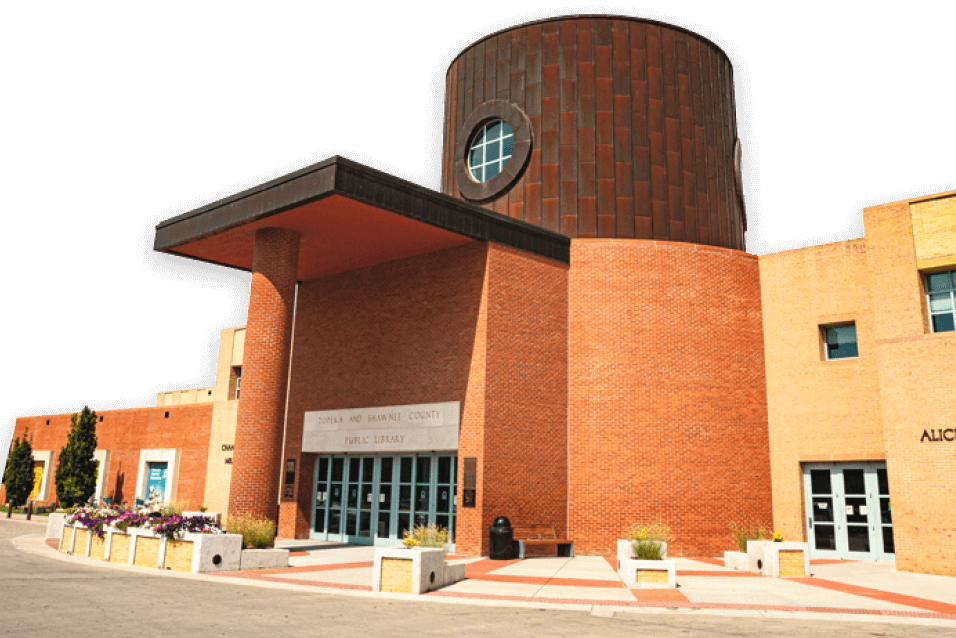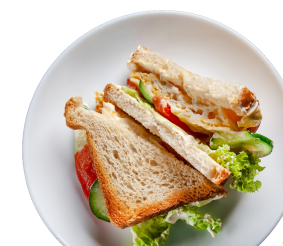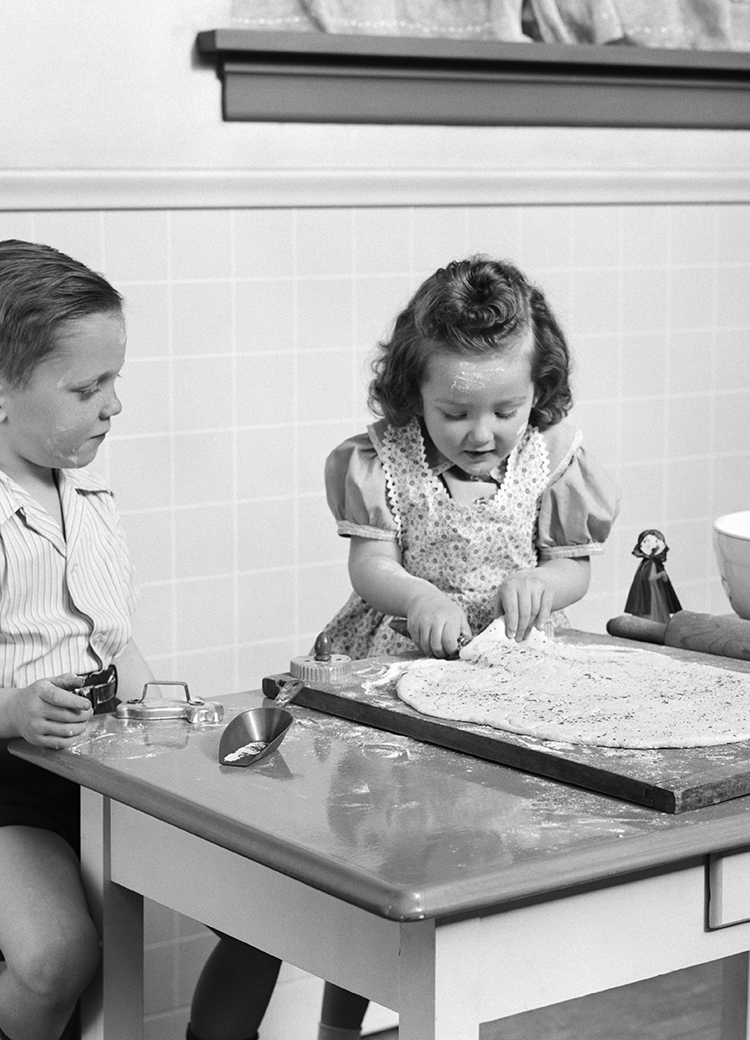Retro recipes from the Topeka Room
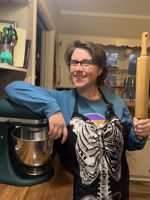 It’s the time of year when baking kicks into high gear, especially when it comes to cookies. As an avid at-home baker, I am constantly on the lookout for interesting new recipes to try. This year I decided to look for some old new recipes and dipped into the newspapers and recipe books available in the Topeka Room. (Photo: The author in her natural habitat: the kitchen)
It’s the time of year when baking kicks into high gear, especially when it comes to cookies. As an avid at-home baker, I am constantly on the lookout for interesting new recipes to try. This year I decided to look for some old new recipes and dipped into the newspapers and recipe books available in the Topeka Room. (Photo: The author in her natural habitat: the kitchen)
The following recipes are from between 1913 and 1946. As you will notice, the measurements and instructions sometimes are a bit vague, so half of the adventure when baking these was hoping I had measured the ingredients correctly!
I decided to make this a group project. After baking I had other library staff members taste test these cookies and share their opinions.
Without further ado, dust off your apron and your rolling pin, roll up your sleeves and join me for some retro baking!
Recipe #1: Brown Sugar Refrigerator Cookies (Mrs. Irene Grant; YWCA Young Matrons’ Cook Book, 1946)
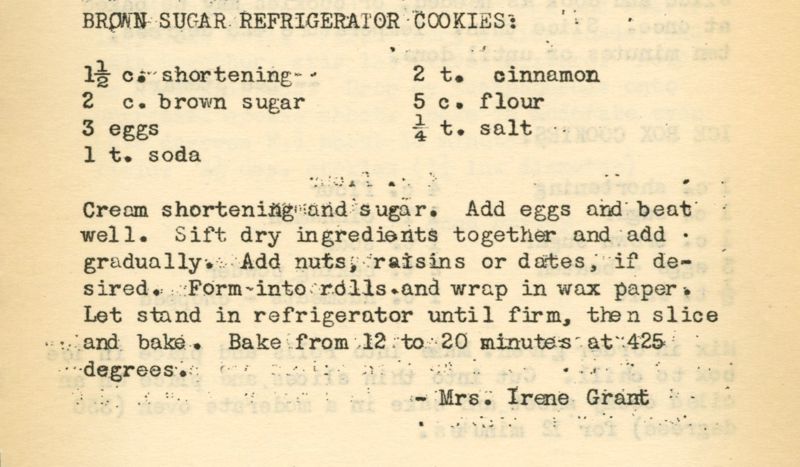 1 ½ cups shortening
1 ½ cups shortening
2 cups brown sugar
3 eggs
1 teaspoon soda
2 teaspoon cinnamon
5 cups flour
¼ teaspoon salt
Cream shortening and sugar. Add eggs and beat well. Sift dry ingredients together and add gradually. Add nuts, raisins or dates, if desired. Form into rolls and wrap in wax paper. Let stand in refrigerator until firm, then slice and bake. Bake from 12 to 20 minutes at 425 degrees.
Baking
I will begin with the easiest of the four recipes. Unlike the rest of our retro recipes, this is the only one that is recent enough that it contains both a bake time and a temperature. However, this lulled me in to a false sense of security (more on that in a bit). After making the dough, I rolled it into a log and wrapped it in cling wrap and refrigerated it overnight.
The dough, even chilled, can be a bit crumbly. I cut it into ¼” sections and baked them at 425°. I decided to start at 15 minutes, which was a big mistake! There’s been almost 80 years of advances in oven technology since this recipe is written. After only 10 minutes smoke was pouring from my oven. I tossed the black little bricks that had been the cookies, lowered the oven temperature to 350° F, and baked for 15 minutes. That worked perfectly!
Taste testers
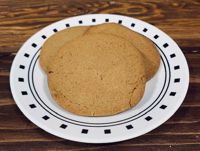 My crack team of library taste testers said this cookie would be best dipped in a hot beverage or in milk. It’s a very crunchy, crumbly cookie that reminded me of a British digestive biscuit. It’s not overwhelmingly sweet, but that means it would pair well with almost anything.
My crack team of library taste testers said this cookie would be best dipped in a hot beverage or in milk. It’s a very crunchy, crumbly cookie that reminded me of a British digestive biscuit. It’s not overwhelmingly sweet, but that means it would pair well with almost anything.
Recipe #2: Cream Cookies (Topeka State Journal, January 4, 1921)
Unlike modern recipes, this one doesn’t come with a short story before getting to the actual recipe.
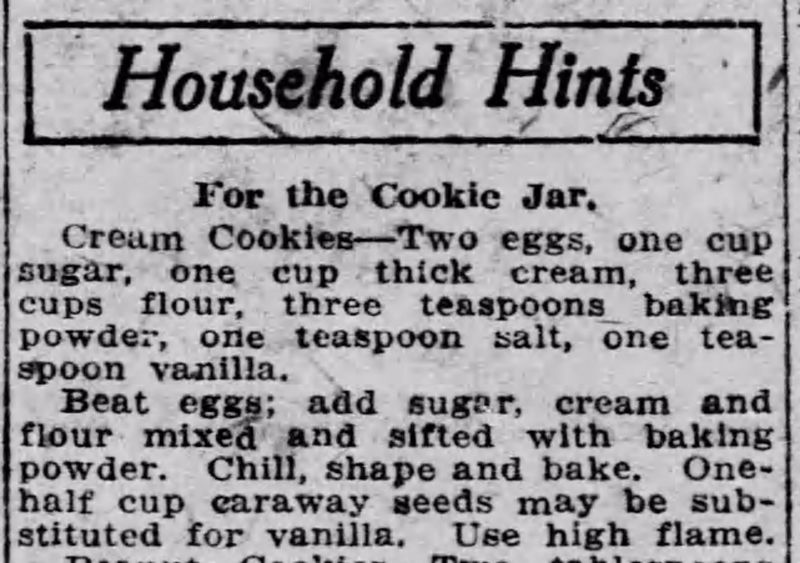 2 eggs
2 eggs
1 cup sugar
1 cup thick cream
3 cups flour
3 teaspoons baking powder
1 teaspoon salt
1 teaspoon vanilla
Beat eggs; add sugar, cream and flour mixed and sifted with baking powder. Chill, shape, and bake. One half cup of caraway seeds may be substituted for vanilla. Use high flame.
Baking
On its face, this recipe seems pretty straightforward. But a closer look reveals the recipe writer seems to have forgotten to explain what to do with the last two ingredients: salt and vanilla. While I appreciate the lack of a short story before this recipe, there is no oven temperature or time for baking.
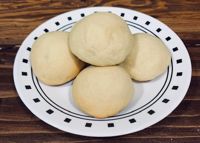 Using my baking knowledge while pretending this was a technical challenge on The Great British Baking Show, I beat the eggs, then added vanilla, cream and sugar. I mixed the flour, baking powder and salt in a separate bowl, then added it slowly to the wet mixture. I chilled the mixture in the fridge for two hours.
Using my baking knowledge while pretending this was a technical challenge on The Great British Baking Show, I beat the eggs, then added vanilla, cream and sugar. I mixed the flour, baking powder and salt in a separate bowl, then added it slowly to the wet mixture. I chilled the mixture in the fridge for two hours.
When it was time to bake, I scooped out about a tablespoon’s worth of the very sticky dough at a time and rolled them into a balls. I baked them at 350°F for 20 minutes.
Taste testers
The taste testers were pleasantly surprised by this one. Most of the comments mentioned it was a nice cake-like cookie. Some were hoping for more flavor and said that this cookie “needed something.” One tester suggested you “pair with Early Grey tea & a mystery.”
Recipe #3: Coffee Cookies (Mrs. P.B. Lee; Central Congregational Church Cook Book, 1913)
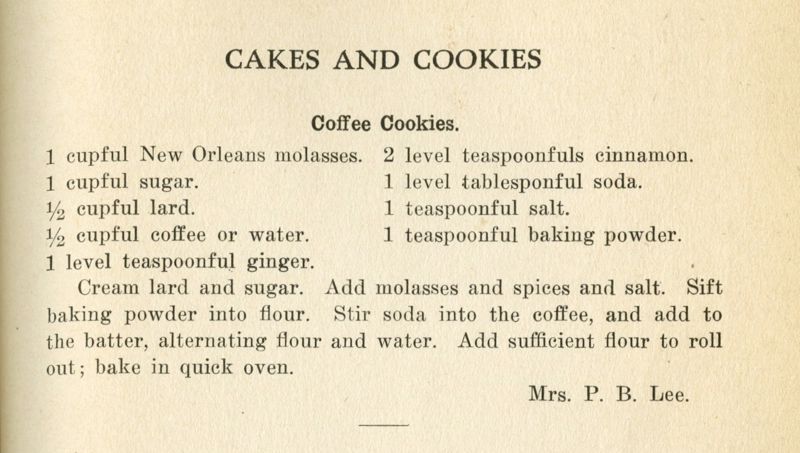 1 cupful New Orleans molasses
1 cupful New Orleans molasses
1 cupful sugar
½ cupful lard
½ cupful coffee or water
1 level teaspoonful ginger
2 level teaspoonfuls cinnamon
1 level tablespoonful soda
1 teaspoonfuls salt
1 teaspoonful baking powder
Cream lard and sugar. Add molasses and spices and salt. Sift baking powder into flour. Stir soda into the coffee, and add to the batter, alternating flour and water. Add sufficient flour to roll out; bake in quick oven.
Baking
Again, this appears to be a straightforward recipe, but this one throws you a curve ball. Notice the directions say to “sift baking powder into flour,” but the list of ingredients doesn’t include flour! Again, donning my Baking Show hat, I started with three cups of flour, and then kept adding it until the dough looked right. In the end, I used 6 ½ cups. Since this ends up being like a gingerbread dough, I also decided to chill the dough for about an hour just to make it easier to handle.
When it came time to bake, I had to research what the term “quick oven” meant. This recipe is from a time before ovens had clearly defined temperature settings, so each baker had to know their own oven and how it heated. Most guides place a “quick or hot” oven at between 400° and 450° F. I played it safe and went for 400° and watched it like a hawk. I ended up baking these for about 12 minutes.
Taste testers
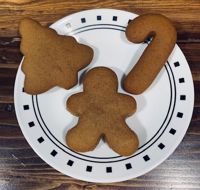 The one word that seemed to sum up these cookies comments was “subtle.” While the cookies might look like gingerbread, the flavor is lacking gingerbread’s typical spiciness. Most of my taste testers liked the softness of the cookie and its texture, but found it was lacking in the promised coffee flavor. Several people mentioned it would be good with a cup of coffee or tea.
The one word that seemed to sum up these cookies comments was “subtle.” While the cookies might look like gingerbread, the flavor is lacking gingerbread’s typical spiciness. Most of my taste testers liked the softness of the cookie and its texture, but found it was lacking in the promised coffee flavor. Several people mentioned it would be good with a cup of coffee or tea.
Recipe #4: Raspberry Cookies (Mrs. Hal A. Waisner, Kansas; Capper’s Farmer Country Cook Book, 1928)
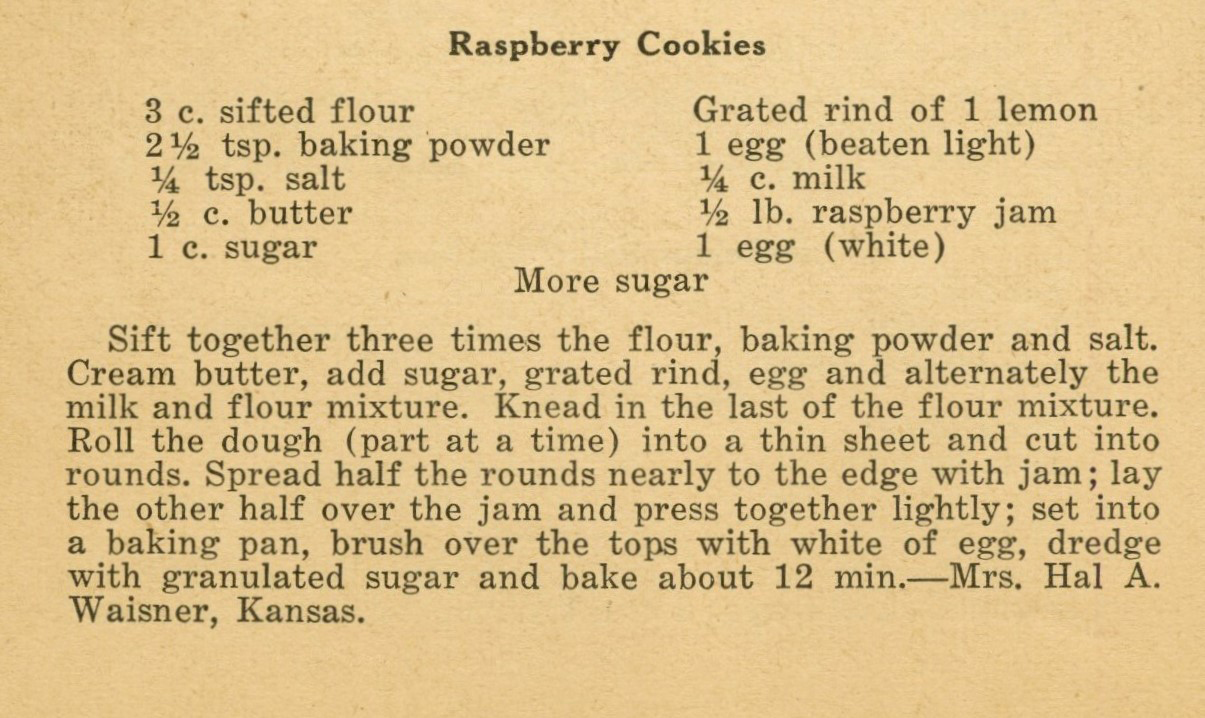 3 cups sifted flour
3 cups sifted flour
2 ½ teaspoons baking powder
¼ teaspoon salt
½ cup butter
1 cup sugar
Grated rind of 1 lemon
1 egg (beaten light)
¼ cup milk
½ lb. raspberry jam
1 egg (white)
Sift together three times the flour, baking powder and salt. Cream butter, add sugar, grated rind, egg and alternately the milk & flour mixture. Knead in the last of the flour mixture. Roll the dough (part at a time) into a thin sheet and cut into rounds. Spread half the rounds nearly to the edge with jam; lay the other half over the jam and press together lightly; set into a baking pan, brush over the tops with white of egg, dredge with granulated sugar and bake about 12 min.
Baking
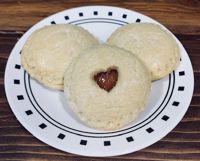 We finish with a more technically challenging recipe. Not only is it lacking in some details, it also is a “some assembly required” cookie. After I got my dough mixed, I separated it into two equal balls and rolled them both out to about 1/8 inch thick. I then used a 2” round cookie cutter. You want to use a cookie cutter that is slightly larger than you think you’ll need to allow for plenty of filling but still have a nice seal to keep the jam from oozing. I decided to try them at 350° 19 minutes.
We finish with a more technically challenging recipe. Not only is it lacking in some details, it also is a “some assembly required” cookie. After I got my dough mixed, I separated it into two equal balls and rolled them both out to about 1/8 inch thick. I then used a 2” round cookie cutter. You want to use a cookie cutter that is slightly larger than you think you’ll need to allow for plenty of filling but still have a nice seal to keep the jam from oozing. I decided to try them at 350° 19 minutes.
On a few of them, I got fancy and created an opening in the tops to give it that classic “Jammy Dodger” look. These ones turned out looking incredibly cute.
Taste testers
This was definitely the sweetest of the four cookies and it also seemed to be the runaway favorite amongst the library staff. Words like “yummy,” “sweet” and “delish” were featured in most of the comments. They really liked the mix of lemon and raspberry. One tester said these cookies were on every holiday cookie tray during their childhood.
Get cooking
Hopefully, you’ve been inspired by some of these historic recipes. And if none of these four recipes float your boat, stop by the Topeka Room! We have several shelves dedicated to cookbooks from local organizations that go back to the 1910s. You can also search through our microfilmed newspapers to see what sorts of recipes were published as far back as the late 1800s! Happy baking!

